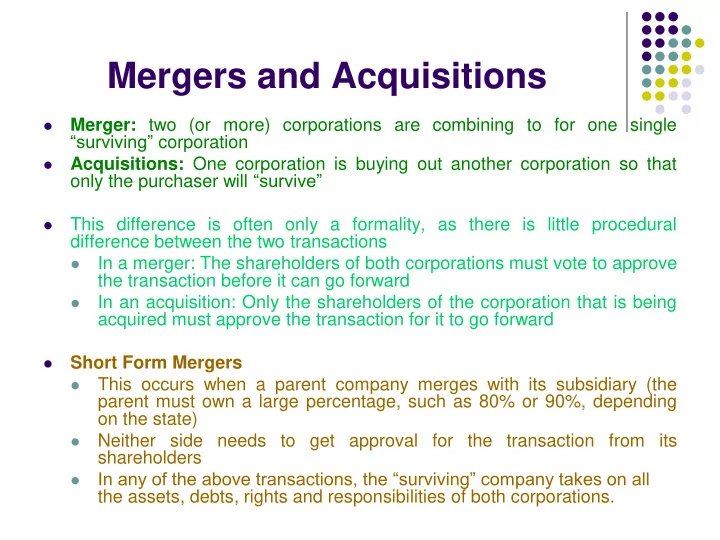

Mergers and Acquisitions Merger: two (or more) corporations are combining to for one single “surviving” corporation Acquisitions: One corporation is buying out another corporation so that only the purchaser will “survive” This difference is often only a formality, as there is little procedural difference between the two transactions In a merger: The shareholders of both corporations must vote to approve the transaction before it can go forward In an acquisition: Only the shareholders of the corporation that is being acquired must approve the transaction for it to go forward Short Form Mergers This occurs when a parent company merges with its subsidiary (the parent must own a large percentage, such as 80% or 90%, depending on the state) Neither side needs to get approval for the transaction from its shareholders In any of the above transactions, the “surviving” company takes on all the assets, debts, rights and responsibilities of both corporations.
Other Relevant Transactions Regarding Corporations Share Exchange: This is when corporations pay for other companies using their own stock rather than using money or assets to make the purchase The goal of a share exchange is often to acquire a “controlling block of shares” in the target corporation Purchase of all assets: This occurs when a corporation buys out the bank accounts, inventory etc. of another corporation without actually acquiring any shares in the target corporation. (It’s used when the buying corporation doesn’t want to liabilities or bad name associated with the target) If a court determines that the transactions are really more like a merger, but this form was used just to avoid liability, a court may hold the buying corporation liable for the debts of the target . Dissolution: The corporation simply stops operating. The assets are used to pay of the corporation’s debt. If there’s anything left, it is split up among the shareholders (this distribution is called a “liquidating dividend”) . Note that some classes of stock may have preference in receiving the liquidation dividend
The Hostile Takeover: Background This occurs when a person or group wants to take over a corporation without the consent of the Board of the target. Usually, corporations that have been doing poorly or are undervalued are prime targets, because it’s easiest to convince the shareholders to go along with the takeover plan. Corporations with large cash stockpiles are attractive takeover targets because the acquirer can then use the cash for its purposes.
The Hostile Takeover: Pros and Cons Pros: The threat of a takeover keeps management in line by encouraging them to keep the corporation’s finances solid The process usually results in new management that will “trim the corporate fat” or in the old management shaping up the finances of the corporation Cons: Often leads to layoffs The battle can be costly, both in terms of money and the time of the corporate managements Often executed by greedy corporate raiders who don’t care about the company’s business, but just care about making as large a profit as possible The threat of a takeover allows greenmail
The Hostile Takeover: Methods Purchase a controlling block without director approval The acquirer simply buys a “control” block on the open market and then can vote in its own slate of directors Problems: That takes a LOT of money The SEC requires filings before you can buy more than 5% of a corporation’s stock on the open market; during this process, management is free to fight the takeover bid Proxy Contest The acquirer sends out proxy solicitations to the shareholders, asking them to vote in the acquirer’s slate of directors Pro: Much less expensive Con: Not under the acquirer’s control and the Board can fight it with its own proxy solicitation “Bear Hug” Offer a high price to the Board for the Board to sell the acquirer a controlling block of the corporation (this is what happened in Van Gorkum) Pro: It’s the least contentious Con: It’s the most expensive
QUIZ TIME!
The Hostile Takeover: Management’s Defenses Propose a plan of their own Try to convince the shareholders to back management and not the bidder Find a “White Knight” Try to find an alternative buyer who will be more friendly to management after the transaction Stagger the Board The makes it harder for the bidder to elect its Board to complete the takeover
The Poisoned Pill Adopt a “poison pill” A “poison pill” is a shareholder rights provision, adopted by the Board, that gives shareholder some enormous right to stock (e.g., that shareholders can buy an unlimited number of shares for 1 penny each) The right only “kicks in” if someone acquires a certain percentage of the corporation Prevents the takeover, because the takeover will trigger the provision, making the company’s stock worthless, thus killing the corporation. A Board can’t just adopt a pill and always prevent all takeover bids forever with it, because that will make the market and the it’s shareholders very upset. Rather, used as negotiating leverage. The “ dead hand poison pill ,” which forces the same directors who adopted the pill to revoke it if it is ever to be revoked, has been held to be unenforceable, as it is too much of a burden on commerce.
Recommend
More recommend